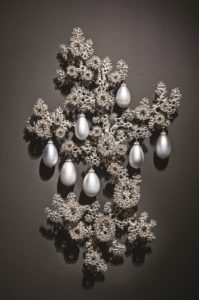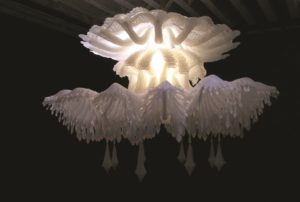Imagine traveling in a Cinderella carriage made of crystalized rock sugar. Or dancing under a translucent silicone chandelier, nine feet wide, in the shape of an enormous glowing jellyfish. These sculptural works populate the dreamlike world created by Australian-born artist Timothy Horn, who now calls Truro home.

Blurring boundaries between fairy tale fantasy and visions of the natural world, Horn encourages viewers to question what lies under the surface of decorative objects. His work has been shown at major museums and galleries, including the de Young in San Francisco, the Museum of Arts and Design in New York, and the National Gallery of Australia in Canberra.
He is fascinated by the extravagance of the Baroque period and, in particular, 17th-century jewelry designs, which he sees as echoing nature’s forms. “If the Renaissance represents solidity and symmetry, the Baroque, by contrast, is like looking at cabbages or lettuces that have gone through all stages of growth to where they start to bulk and go crazy,” Horn says. “I’ve always loved that desperate, last burst of energy.”
Drawn by the allure of jewelry at a young age, Horn went to Victoria College in Prahran, an inner suburb of Melbourne, Australia, intending to become a jewelry artist. “But I felt boxed in and restrained in the jewelry department,” he says. “I couldn’t play with materials. I realized that I liked the scale of sculpture more.” Still, he adds, “Jewelry always remained, lurking there in the background.”
After college, Horn spent five years in Europe. While living in Paris, teaching English with his “heart not in it,” he visited the Louvre nearly every day, drawing 17th-century jewelry and Baroque ornamental objects. Returning to Australia, Horn went for a second undergraduate degree, at the Australian National University, to learn how to work with glass.

“Glass is such a seductive material,” he says. “I was playing with form as a sculptor and wanted to introduce elements of transparency and translucency into my work.”
As he expanded his skills with materials, Horn began to appreciate the parallels between decorative art, which he calls the “poor cousin” to fine art, and the psychological struggles of being a gay man, dealing with rejection and longing to find acceptance and love.
“There was something about the language of the decorative that felt political to me as a gay man marginalized by the mainstream,” he says. “This became the place to start finding answers of my own — the diving off point.”
He moved to Boston to get his M.F.A. in sculpture at MassArt in 2004, and there discovered the collection of glass models by 19th-century father and son Leopold and Rudolf Blaschka in the Harvard Museum of Natural History. Fascinated by the Blaschkas’ collection of jellyfish, anemones, sea slugs, and other maritime invertebrates, Horn began to include sea creatures in his designs.

“The sea has always been very present for me,” Horn says. “I grew up in Melbourne, but my folks also had a house down the coast, on a long, skinny piece of land very similar to Cape Cod called Mornington Peninsula. So, the first time I came to the Cape, it felt very familiar. I remember walking down the beach, finding jellyfish that had been washed up. I think that memory, and then, seeing those glass sea creatures, eventually led to me to make a series of jellyfish.”
Horn was a fellow at the Fine Arts Work Center in Provincetown in 2005-2006, and, while he was there, he created three large-scale translucent chandelier sculptures in the form of jellyfish, using silicone rubber cast in forms and stitched together using fishing line. Both magical and menacing, they are an ode to a seemingly indestructible force of nature.
A trip to Australia’s Great Barrier Reef in 2008 with his partner, writer Art Corriveau, gave Horn a contrasting awareness of nature’s fragility, and brought a strong environmental focus to his work.

“As a seven-year-old, I found the reef mind-blowing — it really left an impression on me,” he says. “Then, as an adult, seeing the first signs of coral bleaching, I felt Australia was not doing enough to avert this disaster.” Spurred by the damage wrought by climate change, Horn began to work with coral patterns, embodying large-scale jewelry designs in these delicate natural forms.
Currently, Horn is one of four artists included in “Forces of Nature: Renwick Invitational 2020,” an exhibit at the Renwick Gallery of the Smithsonian American Art Museum in Washington, D.C., until July 2021. (Due to the recent Covid surge, the Renwick is closed temporarily, but the exhibit can be experienced online at americanart.si.edu/visit/renwick.)
The collision between the natural world and our culture, Horn says, “is essential to what I am trying to get at in my artistic work. Where are we at? Is this the end? Are we going to be able to get it together to save ourselves and our planet? Or are we going to remain locked in denial?”



